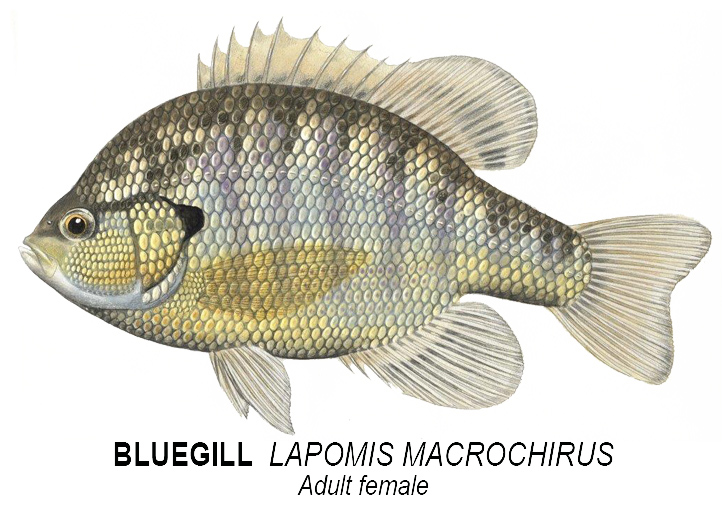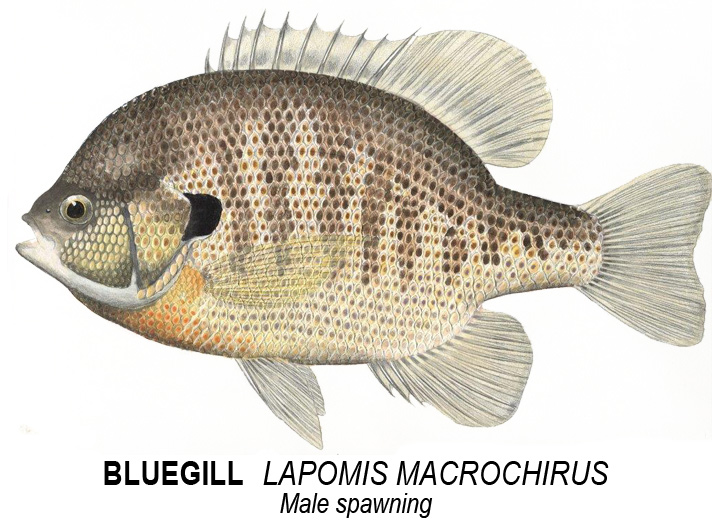Bluegill, November 2014, Fish of the Month!
 Bluegill
Bluegill
Lapomis macrochirus
Local Names:
Bream, Brim, Pond perch, Gold perch, Blue sunfish, Sunfish, Blue joe
Average Size:
7 to 10 inches
Distinguishing Field Marks:
(See the illustration.)
-
The body is very deep and strongly laterally compressed.
-
The mouth is small and upturned.
-
The upper jaw extends back only to the front edge of the eye.
The "ear flap" is large, and entirely black or very dark blue.
The "ear flap" is large, and entirely black or very dark blue. (This solid color ear flap distinguishes the Bluegill from its nearly equally wide ranging cousin, the Pumpkinseed, which has a red and white border on the rear edge of its ear flap.)
The first and second dorsal fins are connected.
The first dorsal fin has 10 spines.
The rear edge of the tail is very slightly undented, with rounded lobes.
Both the pelvic and pectoral fins are long and pointed.
North American Range:
Map to the right shows approximate range in North America.
Diet:
The Bluegill's diet consists mainly of aquatic and terrestrial insects, a wide range of other small aquatic invertebrates, and even some plant matter.
Biology:
Deep water winter aggregations of Bluegills disperse when water temperatures reach about 50 degrees F. At this temperature, sexually mature males move to shallow water areas and choose nesting sites in often large crowded colonial groups. They aggressively defend their site claims as they clear nests by fanning the bottom with their fins and tails until they have reached hard bottom and opened an area of as much as 18 to 24 inches in diameter.
When many nests have been cleared the females arrive and are actively courted by the males. Pairs begin spawning by swimming in circles over the nests, then moving to their center as the female turns onto one side and the male remains upright with their ventral areas in close contact. Small numbers of eggs are released and fertilized, after which the pair begins another cycle of circling the nest followed by spawning. Several females will spawn with each male in each nest. Because the spawning period may last from June into August, nests are often used by more than one breeding pair. As many as from 4,000 to 200,000 fry may hatch from the spawning activity over and into a single nest.
During the 3 to 5 day incubation period, male Bluegills defend their fertilized egg-filled nests and continue to do so for several more days after the eggs have hatched.
Bluegills naturally hybridize with several other species of sunfishes, the Green sunfish, the Pumpkinseed, the Longear, the Redbreast, the Orangespotted, and the Warmouth. The most common cross is Bluegill and Pumpkinseed, as the two species share large portions of their ranges. Where this cross occurs it is nearly impossible to distinguish a specimen's roots.
Fly Fishing for Bluegill:
Ranging throughout nearly all of the United States and a bit of Southern Canada, the Bluegill is the most widely distributed of our small North American sunfishes. They are usually found in the shallow waters of lakes, ponds, and slow moving portions of rivers. They favor densely vegetated areas in all their habitats. In summer, individuals become sedentary and move little. In the hottest weather they may drop into slightly deeper water. In winter they, like most of the small sunfishes, seek deep water where they form loose schools known as winter aggregations in which they continue feeding.
You're likely to find the most exciting approach to fishing for Bluegills is with a light fly rod and small surface poppers or foam bodied bugs. To avoid, as much as possible, constantly hanging up in the vegetation of which these aggressive sunfish are so fond, we recommend your using floating fly lines to match your choice of rod and reel. Three to five weight outfits should be your "go to" for Bluegill fishing.
Bluegills are very aggressive game fish, so much so that they'll frequently come to your flies in groups. Once hooked, they use their disc shaped bodies to set themselves strongly against the pressure of your rod while swimming in wide circles.
Significance to Humans:
The Bluegill continues to be harvested for market, either by netting or angling, and from commercial aquaculture enterprises. The catch is mainly sold locally as fresh fish. That said, the Bluegill also is arguably the sunfish species most sought by anglers. Its willingness to take and its strong fight and the excellent texture and flavor of its meat keep it at or near the top of the pan-fish favorites list. Young Bluegills also serve as forage for the larger sunfishes (Largemouth and Smallmouth bass) and other large predators, such as Northern pike. They are also frequently introduced as forage into private ponds that have been stocked with Largemouth bass.
And incidentally, like all our American small sunfish, Bluegills do very well in a home aquarium.
Status:
Thriving throughout its wide range.







